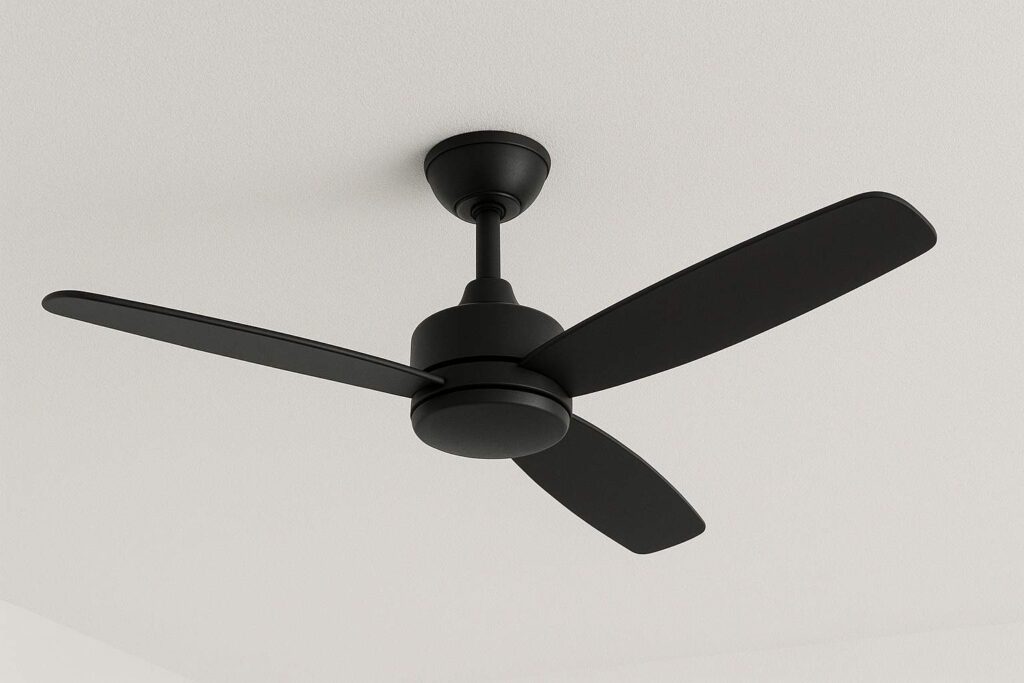
Discover the best ceiling fan for your home with our comprehensive guide. Learn about features, benefits, top brands, and tips for optimal performance and efficiency.
Introduction
As the temperatures rise, staying cool indoors becomes a priority. While air conditioners are a popular choice for cooling, ceiling fans remain a reliable and energy-efficient solution to keep the air circulating and temperatures comfortable.
For maximum comfort during peak summers, you can also pair a ceiling fan with an air cooler or ensure uninterrupted usage during outages with a home inverter.
Whether you’re looking to replace an old fan or purchase one for a new space, there’s a lot to consider before making your choice.
In this guide, we will explore what to look for in a ceiling fan, the different types available, and some of the best models on the market today.
What is a Ceiling Fan?
A ceiling fan is a mechanical fan suspended from the ceiling that circulates air to improve air circulation. It is commonly used to cool down a room by creating a wind-chill effect. This makes the room feel cooler, even if the temperature remains the same. Ceiling fans are typically powered by an electric motor and come with various blade sizes, motor speeds, and energy-saving features.
Benefits of Using a Ceiling Fan
1. Energy Efficiency
Ceiling fans are highly energy-efficient, consuming much less power than air conditioners, making them an ideal choice for budget-conscious households.
Similarly, many modern appliances like water purifiers and juicers are also designed to deliver high performance while keeping electricity costs low.
2. Cost-Effective
The initial cost of installing a ceiling fan is relatively low compared to air conditioning systems, and they also help reduce electricity bills over time.
3. Improved Air Circulation
Ceiling fans keep air circulating, preventing the feeling of stagnation in a room and making the environment more comfortable.
4. Versatility
Many ceiling fans come with adjustable speeds and reversible motors, allowing you to use them year-round, as they can circulate warm air in the winter too.
5. Sustainability
By using ceiling fans instead of air conditioners, you’re contributing to a more sustainable and eco-friendly living by reducing your carbon footprint.
Types of Ceiling Fans
1. Standard Ceiling Fans
- The most common type of fan
- Suitable for medium to large rooms
- Available in various sizes and styles
2. Energy-Efficient Ceiling Fans
- Designed to consume less electricity while maintaining performance
- Often come with DC motors or BLDC technology for superior energy efficiency
3. Smart Ceiling Fans
- Can be controlled via smartphone apps or voice assistants
- Often have features like remote controls, timers, and adjustable speeds
4. High-Speed Ceiling Fans
- Designed for rooms that need quick and effective cooling
- Ideal for areas with hot and humid climates
5. Decorative Ceiling Fans
- Designed with aesthetics in mind, these fans have stylish blades and finishes to match home décor
- Available in various colors and materials like wood, metal, or glass
Factors to Consider Before Buying a Ceiling Fan
1. Room Size
The size of the room determines the size and power of the fan you need. A larger room requires a fan with a larger blade span or higher motor speed for effective air circulation.
2. Blade Size and Design
Ceiling fans come with different blade spans, usually ranging from 36 inches to 56 inches. A larger blade span will move more air, making it suitable for bigger rooms.
3. Motor Type
Ceiling fans typically use one of the following motor types:
- AC Motor: Provides good airflow at an affordable price.
- DC Motor: More energy-efficient and quieter than AC motors.
4. Energy Efficiency
If you’re looking to save on energy bills, opt for energy-efficient ceiling fans with DC motors or BLDC technology. These consume less power while offering optimal performance.
Energy savings don’t stop at fans — investing in an air cooler or inverter can also make your home more efficient and eco-friendly.
5. Noise Level
Look for fans that operate quietly, especially if the fan is in a bedroom or living room where silence is important.
6. Design and Style
Ceiling fans come in a range of designs, from modern to traditional. Choose a fan that complements the style of your room.
7. Remote Control and Smart Features
If convenience is important, consider a smart ceiling fan or one with a remote control, allowing you to control speed and other features from anywhere in the room.
Top 5 Ceiling Fans in India (2025)
1. Crompton High Speed Ceiling Fan
- 400 RPM motor speed
- 1200mm blade span
- Energy-efficient motor
- 2-year warranty
2. Bajaj Maxima 1200mm Ceiling Fan
- 370 RPM motor speed
- Aerodynamic blades for high airflow
- Stylish design with a rust-proof body
3. Usha Striker 1200mm Ceiling Fan
- Super fast motor with 380 RPM
- Wide blade span for enhanced air delivery
- Available in multiple colors
4. Havells Stealth 1200mm Ceiling Fan
- BLDC motor for energy efficiency
- Sleek and modern design
- Remote control and smart features
5. Orient Electric Apex-FX 1200mm Ceiling Fan
- Aerodynamic blades for greater air circulation
- Silent operation and low maintenance
- Sleek metallic finish

Ceiling Fan Installation and Maintenance
Installation
- Ensure the ceiling fan is installed at a height of at least 8 to 9 feet from the floor for effective airflow.
- Always install the fan in the center of the room for uniform air circulation.
- Opt for professional installation for proper wiring and safety.
Maintenance
- Clean the fan blades regularly to avoid dust accumulation that can reduce efficiency.
- Lubricate the motor if required for smooth operation.
- Inspect the fan for any loose parts, especially the motor and blades.
- Replace the fan if the motor is making unusual noises or if the airflow is weak.
Ceiling Fan vs Air Conditioner: Which One to Choose?
Feature | Ceiling Fan | Air Conditioner |
Energy Consumption | Low energy usage | High energy consumption |
Cooling Efficiency | Provides the wind-chill effect | Direct cooling through refrigerant |
Installation Cost | Low installation cost | High installation cost |
Maintenance | Easy and inexpensive | Expensive and requires servicing |
Cooling Speed | Slower, takes time to cool | Rapid cooling |
Noise | Quiet, depending on the motor | It can be noisy depending on the model |
If you’re leaning towards eco-friendly cooling, our air cooler buying guide offers detailed comparisons to help you choose the right summer companion.
Common Problems with Ceiling Fans
1. Fan Not Turning
This could be due to a loose connection, a faulty motor, or a broken capacitor. In such cases, call a technician for repair.
2. Fan Wobbling
A wobbly ceiling fan is often caused by uneven blade positioning or an unbalanced motor. Tightening the screws or adjusting the blades should help.
3. Excessive Noise
If your ceiling fan is noisy, the issue could be due to loose parts, dust accumulation, or worn-out motor bearings. Regular cleaning and lubrication can prevent this problem.
Conclusion
A ceiling fan is a smart, energy-efficient addition to any home, offering comfort, savings, and environmental benefits.
To build a complete summer setup, explore our air cooler guide for additional cooling options and water purifier guide to ensure safe hydration all year round.
By choosing the right fan based on room size, motor type, and design, you can enjoy optimal airflow and comfort. Whether you prefer a high-speed fan for fast cooling or a decorative fan to enhance the aesthetic of your room, there’s a model to suit every need.
Investing in a good ceiling fan ensures long-term benefits, keeping your spaces cool, comfortable, and stylish without the high costs associated with air conditioners.
